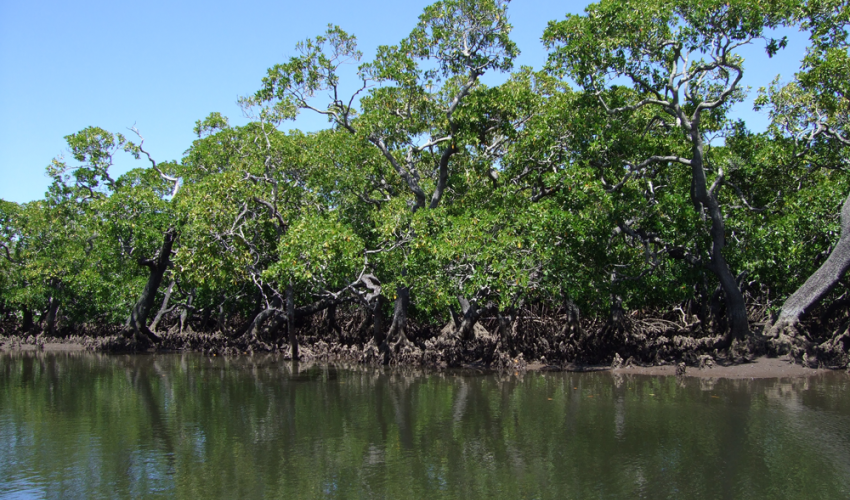Mangroves are the first line of defence for coastal communities as they stabilize the seashore regions even where rivers mix into them by slowing erosion. They also provide a natural barrier protecting coastal communities from increased storm surge, flooding, and hurricanes. Mangroves are shrubs or a kind of small trees that grow in coastal saline brackish water. Mangroves occur worldwide in the tropic and subtropics, mainly between 25°N and 25°S latitudes. There are about 80 different species of mangrove trees in various categories like black, red, white, and buttonwood. All of these Mangroves grow in areas with low oxygenated soil where slow-moving water allows fine sediments to accumulate. They mainly protect the shoreline from damaging winds and waves. They also maintain water quality and clarity filtering pollutants and trapping sediments originating from land. They are salt-tolerant trees that grow over swamp soil. They have stilt roots also called breathing roots (aerial pneumatophores) that help them adapt to deoxygenated conditions.
It was observed that the city of Kolkata was protected or shielded from the cyclone named Amphan and many other storm surges due to the Mangrove cover in Sunderbans. In spite of being of protecting nature, mangroves are now facing an existential threat due to anthropogenic activities. It has been observed that they can go extinct, due to lack of care and deforestation. The mangrove which is situated on Sindh’s coastal line is also in danger, as the area of forests is gradually diminishing.
The first-ever assessment of mangrove species by the IUCN red list found that 11 out of 70 mangrove species were threatened with extinction, including two which are listed as critically endangered. Over a third of the Mangroves have already disappeared, and in regions such as the Americas, they are being cleared at a faster rate than tropical rainforests.
Much of that clearance is to reclaim land for agriculture, industrial development, and infrastructure projects. In addition to climate change and pollution, there are also local threats. These include overharvesting of wood for fuel and construction, dams and irrigation that reduce the flow of water reaching the forests, and overfishing causing disruption to food chains and fish communities. Humanity is destroying a coastal ecosystem that helps sustain life and livelihoods. There are many reasons why we should be doing much more to preserve mangrove forests some of which are described below.
The sturdy root systems of mangrove trees help form a natural barrier against violent storm surges and floods. River and land sediment is trapped by the roots, which protects coastline areas and slows erosion. This filtering process also prevents harmful sediment from reaching coral reefs and sea-grass meadows.
In 2017, the UN Ocean Conference estimated that nearly 2.4 billion people live within 100 km of the coast. Mangroves provide valuable protection for communities at risk from sea-level rises and severe weather events caused by climate change. Coastal forests help the fight against global warming by removing carbon dioxide from the atmosphere, most of which is stored within the plant. When mangrove tree roots, branches, and leaves die they are usually covered by soil, which is then submerged under tidal water, slowing the breakdown of materials and boosting carbon storage.
Research shows that coastal mangroves outperform most other forests in their capacity to store carbon. An examination of 25 mangrove forests across the Indo-Pacific region found that per hectare, they held up to four times more carbon than other tropical rainforests. Many people living in and around mangroves depend on them for their livelihood. The trees are a reliable source of wood for construction and fuel, which is prized for its hardy resistance to both rot and insects. However, in some areas, the wood has been harvested commercially for pulp, wood chip, and charcoal, raising concerns about sustainability.
In mangrove regions, plant extracts are collected by locals for their medicinal qualities, and the leaves of mangrove trees are often used for animal fodder. The forest waters provide local fishermen with a rich supply of fish, crabs, and shellfish to sell for income. Sustainable tourism offers a stimulus to preserve existing mangrove areas, with the potential to generate income for local inhabitants. Often located near to coral reefs and sandy beaches, the forests provide a rich environment for activities like sports fishing, kayaking, and bird-watching tours.
It is also important to maintain a balance between visitor numbers and protecting the forests’ delicate ecosystem. If held at sustainable levels, ecotourism could provide the perfect motivation to protect mangroves, instead of clearing them for mass tourism developments. Human activity has caused huge biodiversity loss in land and marine ecosystems around the globe, endangering many plant and animal species. By filtering coastal waters, mangroves form a nutrient-rich breeding ground for numerous species that thrive above and below the waterline.
A huge variety of wildlife lives or breeds in the mangrove ecosystem, including numerous fish, crab and shrimp species, mollusks, and mammals like sea turtles. The trees are home to an array of nesting, breeding, and migratory birds. When mangrove forests are cleared, valuable habitat is lost, threatening the survival of myriad species.
But, that is not the whole story. The forests are also a potential source of undiscovered biological materials that could benefit mankind, such as antibacterial compounds and pest-resistant genes, which are also lost when coastal areas are cleared.
Land clearance of mangrove areas and other forests like the Amazon has had a major impact on different species. The International Union for Conservation of Nature’s (IUCN) Red List shows that of 68,574 species of invertebrates, 8,374 were on the brink of extinction. Protecting natural ecosystems like mangrove forests not only helps preserve biodiversity; it also helps preserve a vital resource for local communities.
(Source: IUCN, WEF)





